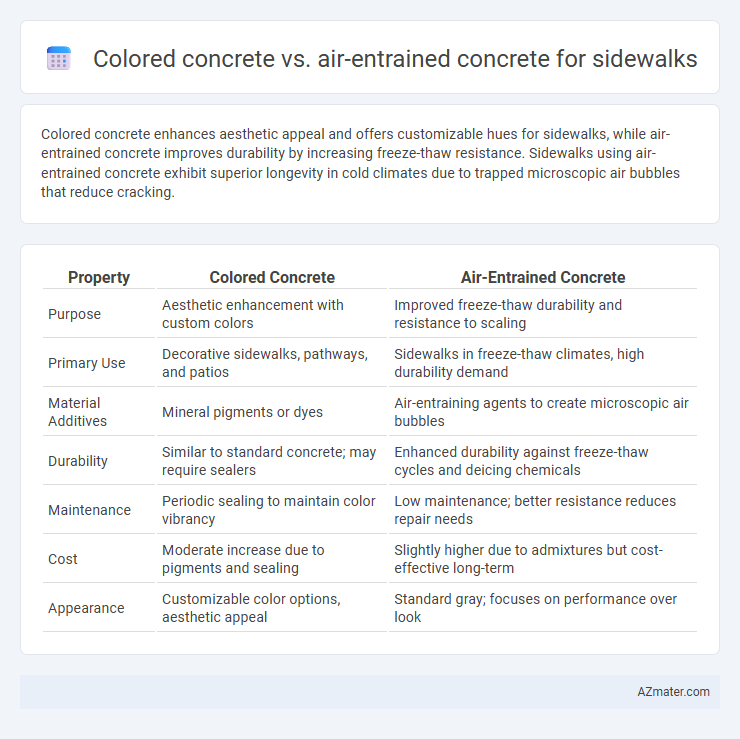Colored concrete enhances aesthetic appeal and offers customizable hues for sidewalks, while air-entrained concrete improves durability by increasing freeze-thaw resistance. Sidewalks using air-entrained concrete exhibit superior longevity in cold climates due to trapped microscopic air bubbles that reduce cracking.
Table of Comparison
| Property | Colored Concrete | Air-Entrained Concrete |
|---|---|---|
| Purpose | Aesthetic enhancement with custom colors | Improved freeze-thaw durability and resistance to scaling |
| Primary Use | Decorative sidewalks, pathways, and patios | Sidewalks in freeze-thaw climates, high durability demand |
| Material Additives | Mineral pigments or dyes | Air-entraining agents to create microscopic air bubbles |
| Durability | Similar to standard concrete; may require sealers | Enhanced durability against freeze-thaw cycles and deicing chemicals |
| Maintenance | Periodic sealing to maintain color vibrancy | Low maintenance; better resistance reduces repair needs |
| Cost | Moderate increase due to pigments and sealing | Slightly higher due to admixtures but cost-effective long-term |
| Appearance | Customizable color options, aesthetic appeal | Standard gray; focuses on performance over look |
Introduction to Colored and Air-Entrained Concrete
Colored concrete incorporates pigments during mixing to enhance aesthetic appeal and customize sidewalk surfaces with vibrant hues while maintaining durability. Air-entrained concrete contains microscopic air bubbles introduced to improve freeze-thaw resistance, which is crucial for sidewalks exposed to harsh weather conditions. Selecting between colored and air-entrained concrete depends on balancing visual design preferences with performance requirements in cold climates.
Defining Colored Concrete: Features and Applications
Colored concrete incorporates integral pigments to provide durable, vibrant hues that enhance aesthetic appeal and curbside visibility for sidewalks. Its features include UV-resistant color stability, customizable shades, and compatibility with various finishing techniques such as stamping and exposed aggregate. Widely applied in pedestrian pathways, parks, and urban streetscapes, colored concrete offers both functional and decorative benefits, contrasting with air-entrained concrete, which prioritizes freeze-thaw durability.
Understanding Air-Entrained Concrete: Key Characteristics
Air-entrained concrete contains microscopic air bubbles that enhance freeze-thaw durability and reduce cracking in sidewalks exposed to harsh weather conditions. This type of concrete improves resistance to scaling caused by de-icing chemicals and increases overall longevity compared to standard concrete mixes. The air void system formed in air-entrained concrete also aids in mitigating damage from water expansion during freezing cycles, making it a crucial choice for sidewalks in cold climates.
Performance Comparison: Durability in Sidewalks
Colored concrete offers enhanced resistance to fading and surface wear, making it ideal for aesthetic longevity in sidewalks. Air-entrained concrete significantly improves freeze-thaw durability by creating microscopic air bubbles that reduce internal pressure from water expansion. The choice depends on the balance between visual appeal and climatic resistance, with air-entrained concrete favored in colder regions for extended sidewalk lifespan.
Aesthetic Appeal: Customization vs Functionality
Colored concrete offers extensive customization options, allowing for vibrant hues and patterns that enhance the sidewalk's aesthetic appeal and complement surrounding landscapes. Air-entrained concrete, while primarily designed to improve durability and resistance to freeze-thaw cycles, provides a more traditional appearance with limited color variation. Choosing between the two depends on prioritizing visual design elements or long-term functionality in sidewalk construction.
Weather Resistance: Freeze-Thaw Performance
Colored concrete utilizes integral pigments to enhance aesthetics but may require sealants to maintain durability against freeze-thaw cycles, as pigments do not inherently improve weather resistance. Air-entrained concrete incorporates microscopic air bubbles that significantly improve freeze-thaw performance by providing space for water expansion, reducing cracking and scaling in cold climates. For sidewalks exposed to harsh winter weather, air-entrained concrete offers superior freeze-thaw durability, extending pavement lifespan and minimizing maintenance costs.
Installation and Maintenance Considerations
Colored concrete enhances sidewalk aesthetics with pigment-mixed blending, requiring careful mixing to maintain uniform color and surface finish during installation. Air-entrained concrete incorporates microscopic air bubbles to improve freeze-thaw durability, demanding precise air content control through admixtures and consistent curing practices. Maintenance for colored concrete involves regular sealing to preserve vibrancy, while air-entrained concrete requires monitoring for air void stability to sustain long-term resistance to cracking in cold climates.
Cost Analysis: Colored vs Air-Entrained Concrete
Colored concrete typically incurs higher initial costs due to the added pigments and labor-intensive mixing process, while air-entrained concrete remains more cost-effective as it primarily involves adding air-entraining agents to the standard mix. Maintenance expenses for colored concrete may be higher over time because fading and discoloration require periodic resurfacing or sealing, unlike air-entrained concrete, which offers enhanced freeze-thaw durability and reduces long-term repair costs. Overall, air-entrained concrete provides a more economical option for sidewalks in cold climates, balancing durability with lower upfront and maintenance expenses.
Environmental Impact and Sustainability
Colored concrete uses integral pigments that do not affect the concrete's durability or environmental footprint, making it a sustainable choice with minimal impact during production. Air-entrained concrete incorporates tiny air bubbles to improve freeze-thaw resistance, reducing maintenance needs and extending sidewalk lifespan, which enhances resource efficiency over time. Both types contribute to sustainability by promoting long-lasting sidewalks, but air-entrained concrete offers superior resilience in cold climates, lowering the need for repairs and associated environmental costs.
Choosing the Right Concrete for Your Sidewalk Project
Colored concrete offers aesthetic customization and can enhance curb appeal with various pigments, while air-entrained concrete improves durability by incorporating tiny air bubbles that resist freeze-thaw cycles and reduce cracking. Selecting the right concrete for your sidewalk depends on balancing visual preferences against environmental conditions like climate and expected wear. For climates with frequent freeze-thaw cycles, air-entrained concrete provides superior longevity, whereas colored concrete is ideal for projects prioritizing design and visual impact.

Infographic: Colored concrete vs Air-entrained concrete for Sidewalk
 azmater.com
azmater.com